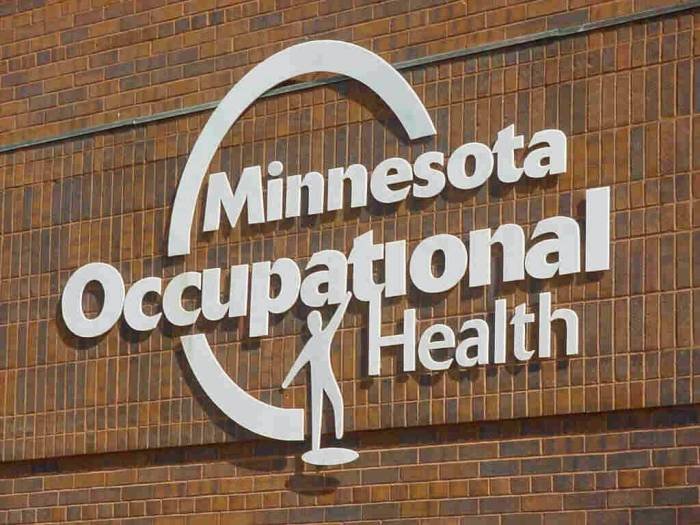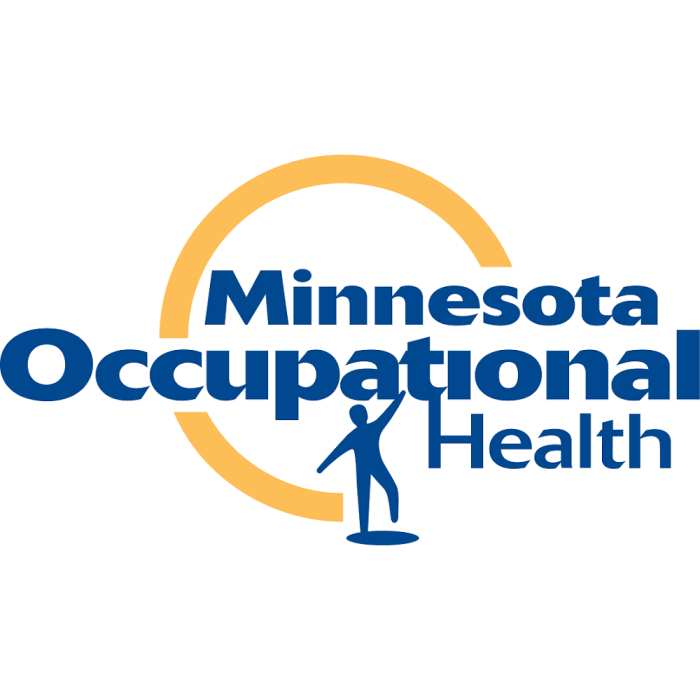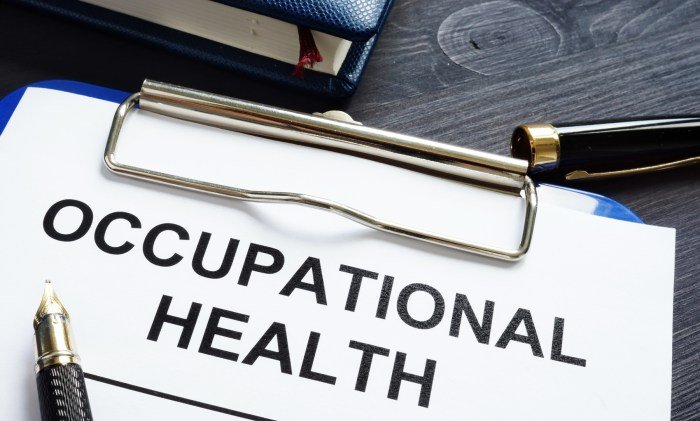Minnesota Occupational Health delves into the crucial aspects of workplace safety and health in the state, examining the unique challenges and opportunities that arise in a diverse range of industries. From construction and manufacturing to healthcare and education, Minnesota’s workforce faces various occupational health risks, making it essential to understand the regulations, services, and preventative measures in place.
This guide explores the landscape of occupational health in Minnesota, highlighting the key industries, regulations, and common health issues. It examines the roles of government agencies, healthcare providers, and private organizations in promoting worker well-being and provides a comprehensive overview of resources available to workers and employers.
Minnesota Occupational Health Landscape

Minnesota has a diverse economy, with key industries contributing significantly to its economic growth. These industries, however, come with inherent occupational health risks that necessitate robust safety measures and regulations.
Key Industries and Associated Occupational Health Risks
Minnesota’s economy is driven by a variety of industries, each presenting its unique occupational health challenges.
- Manufacturing:This sector, a significant contributor to Minnesota’s economy, exposes workers to various hazards, including exposure to chemicals, noise, and machinery, which can lead to respiratory problems, hearing loss, and musculoskeletal injuries.
- Agriculture:Minnesota is a major agricultural producer, and agricultural workers face risks associated with exposure to pesticides, machinery, and extreme weather conditions. These factors can contribute to respiratory illnesses, skin problems, and musculoskeletal injuries.
- Construction:The construction industry is another major employer in Minnesota, and workers in this sector are exposed to risks such as falls, exposure to hazardous materials, and heavy lifting, leading to injuries and illnesses like fractures, sprains, and respiratory problems.
- Healthcare:Minnesota’s healthcare sector, while essential, also presents occupational health risks for workers. Healthcare workers are exposed to infectious diseases, needle-stick injuries, and ergonomic hazards, potentially leading to infections, musculoskeletal disorders, and mental health issues.
- Transportation and Warehousing:This sector, vital for moving goods and people, exposes workers to risks associated with driving, lifting, and exposure to hazardous materials, leading to injuries and illnesses such as back pain, carpal tunnel syndrome, and respiratory problems.
Occupational Health Regulations and Standards, Minnesota occupational health
Minnesota has a comprehensive set of occupational health regulations and standards enforced by the Minnesota Department of Labor and Industry (DLI). These regulations aim to protect workers from workplace hazards and promote a safe and healthy work environment.
- Minnesota Occupational Safety and Health Act (OSHA):This law sets minimum safety and health standards for workplaces, requiring employers to provide a safe and healthy work environment for their employees. The act covers a wide range of hazards, including exposure to chemicals, noise, and machinery, and requires employers to implement safety programs and provide training to their employees.
Minnesota’s occupational health landscape is vast, encompassing numerous industries. While many focus on traditional sectors like manufacturing, the beauty industry also presents unique health concerns. For instance, receptionists in salons often face ergonomic challenges and potential exposure to chemicals. If you’re interested in a career in this field, consider exploring beauty salon reception jobs and understanding the associated occupational health considerations.
- Worker’s Compensation:This program provides benefits to workers who suffer work-related injuries or illnesses. It covers medical expenses, lost wages, and other benefits, ensuring that workers have financial support during their recovery.
- Right-to-Know Laws:These laws require employers to inform employees about potential hazards in the workplace and provide them with training on how to protect themselves from these hazards. This includes providing Material Safety Data Sheets (MSDS) for hazardous materials.
Prevalence of Occupational Injuries and Illnesses
Minnesota’s occupational injury and illness rates are closely monitored by the DLI. Data suggests that the state’s rates are generally comparable to national averages, with some variations across industries.
- National Safety Council (NSC):According to the NSC, Minnesota’s overall rate of workplace fatalities in 2020 was 3.0 per 100,000 workers, slightly higher than the national average of 2.8. This data highlights the importance of continued efforts to improve workplace safety in Minnesota.
- Bureau of Labor Statistics (BLS):The BLS reported that Minnesota’s nonfatal occupational injury and illness rate in 2020 was 2.7 cases per 100 full-time equivalent (FTE) workers, slightly lower than the national average of 2.9 cases per 100 FTE workers.
Occupational Health Services in Minnesota

Minnesota offers a comprehensive range of occupational health services, reflecting the state’s commitment to worker well-being and workplace safety. These services aim to prevent work-related injuries and illnesses, promote a healthy and productive workforce, and ensure compliance with relevant regulations.
Types of Occupational Health Services
Minnesota’s occupational health services cater to a wide array of needs, encompassing preventive measures, injury and illness management, and workplace safety programs. These services include:
- Pre-employment screenings:These assessments evaluate a candidate’s physical and mental fitness for a specific job, ensuring they possess the necessary capabilities to perform their duties safely and effectively.
- Health surveillance:Regular health monitoring programs help identify potential health risks associated with specific occupations, enabling early intervention and preventive measures. This can involve periodic checkups, blood tests, and other screenings tailored to the workplace environment.
- Injury and illness management:Occupational health professionals provide prompt and appropriate care for work-related injuries and illnesses, ensuring timely treatment and facilitating a smooth return to work process.
- Ergonomics assessments:These evaluations analyze workstations and work processes to identify potential ergonomic hazards, minimizing the risk of musculoskeletal injuries and promoting a more comfortable and efficient work environment.
- Substance abuse programs:Occupational health services often include programs to address substance abuse issues in the workplace, offering counseling, support groups, and testing services to promote a healthy and productive work environment.
- Mental health services:Recognizing the increasing prevalence of mental health concerns in the workplace, occupational health services provide mental health support and resources, including stress management techniques, counseling, and referral to mental health professionals.
- Workplace safety training:These programs educate employees on safe work practices, hazard identification, and emergency procedures, fostering a culture of safety and reducing the risk of accidents and injuries.
Role of Stakeholders
A collaborative effort among government agencies, healthcare providers, and private organizations is crucial for delivering effective occupational health services in Minnesota.
Government Agencies
Government agencies play a vital role in setting standards, enforcing regulations, and providing resources to promote occupational health. The Minnesota Department of Labor and Industry (DLI) is the primary agency responsible for workplace safety and health, overseeing workplace safety inspections, investigating workplace accidents, and providing guidance and training on occupational health issues.
Other agencies, such as the Minnesota Department of Health (MDH), contribute to occupational health by addressing specific health concerns related to the workplace, such as infectious diseases and environmental hazards.
Healthcare Providers
Healthcare providers, including physicians, nurses, and occupational therapists, play a critical role in delivering direct occupational health services. They provide pre-employment screenings, injury and illness management, and health surveillance programs, working closely with employers to ensure the health and well-being of their workforce.
Private Organizations
Private organizations, such as occupational health clinics, consulting firms, and insurance companies, offer a wide range of specialized occupational health services. These organizations can provide customized solutions tailored to the specific needs of individual businesses, including workplace safety assessments, ergonomic evaluations, and employee health and wellness programs.
Availability and Accessibility
Occupational health services are generally available across different regions of Minnesota, although accessibility may vary depending on factors such as population density, industry concentration, and the availability of healthcare providers.
The Minnesota Department of Labor and Industry provides a directory of occupational health providers on its website, which can be a valuable resource for employers and individuals seeking occupational health services.
Common Occupational Health Issues in Minnesota

Minnesota, like other states, faces a range of occupational health issues impacting the well-being of its workforce. Understanding these issues is crucial for promoting a safer and healthier work environment. This section delves into the most prevalent occupational health concerns in Minnesota, examining their contributing factors and potential solutions.
Musculoskeletal Disorders
Musculoskeletal disorders (MSDs) are a leading cause of work-related injuries and illnesses in Minnesota. These disorders affect the muscles, tendons, ligaments, nerves, and bones, resulting in pain, stiffness, and limitations in movement. MSDs can arise from repetitive motions, awkward postures, forceful exertions, and prolonged static positions.
- Repetitive Motion Injuries:Workers performing repetitive tasks, such as assembly line workers, cashiers, and data entry personnel, are at risk of developing MSDs, particularly in their hands, wrists, and elbows.
- Awkward Postures:Maintaining awkward postures for extended periods, like bending, twisting, or reaching, can strain muscles and joints, leading to MSDs in the back, neck, and shoulders.
- Forceful Exertion:Jobs involving heavy lifting, pushing, or pulling can put excessive stress on muscles and joints, increasing the risk of MSDs.
- Prolonged Static Positions:Standing or sitting in the same position for long durations can restrict blood flow and lead to muscle fatigue and discomfort, contributing to MSDs in the lower back, legs, and feet.
Respiratory Illnesses
Exposure to airborne contaminants in the workplace can lead to respiratory illnesses, affecting the lungs and airways. Common respiratory illnesses include asthma, chronic obstructive pulmonary disease (COPD), and lung cancer.
- Dust:Exposure to dust, particularly in industries like construction, mining, and agriculture, can irritate the lungs and lead to respiratory problems. Different types of dust, including silica dust and wood dust, can cause specific lung diseases.
- Fumes and Gases:Working with chemicals, solvents, and welding materials can release fumes and gases that can damage the lungs and airways. Exposure to these substances can cause asthma, bronchitis, and other respiratory illnesses.
- Biological Agents:Workers in healthcare, agriculture, and waste management are exposed to biological agents like bacteria, viruses, and fungi. These agents can trigger respiratory infections and allergic reactions.
Mental Health Concerns
Mental health issues, such as stress, anxiety, and depression, are increasingly recognized as significant occupational health concerns. Work-related stressors, including job demands, workplace conflicts, and lack of control over work, can contribute to mental health problems.
- Job Demands:High workload, tight deadlines, and demanding work environments can create excessive stress, leading to burnout, anxiety, and depression.
- Workplace Conflicts:Interpersonal conflicts, bullying, and harassment can negatively impact mental well-being, creating a stressful and toxic work environment.
- Lack of Control over Work:Feeling a lack of autonomy or control over one’s work can lead to frustration, anxiety, and decreased job satisfaction, potentially contributing to mental health issues.
Exposure to Hazardous Substances
Exposure to hazardous substances in the workplace can have immediate and long-term health consequences. These substances can cause a wide range of health problems, including skin irritation, respiratory issues, cancer, and reproductive problems.
- Chemicals:Workers in manufacturing, construction, and agriculture are often exposed to chemicals that can cause skin irritation, respiratory problems, and even cancer. Examples include solvents, pesticides, and asbestos.
- Metals:Exposure to metals, such as lead, mercury, and cadmium, can cause a variety of health problems, including neurological damage, kidney damage, and cancer. Workers in industries like manufacturing, mining, and construction are at risk.
- Radiation:Workers in healthcare, nuclear power, and research are exposed to radiation, which can increase the risk of cancer and other health problems. Proper safety protocols and protective measures are essential.
Prevention and Management of Occupational Health Issues: Minnesota Occupational Health
![]()
Minnesota prioritizes the prevention and management of occupational health issues, recognizing their impact on workers’ well-being and economic productivity. The state employs a multifaceted approach, integrating strategies, programs, and resources to create a safer and healthier work environment for all.
Workplace Safety Training
Workplace safety training is a cornerstone of Minnesota’s occupational health strategy. Employers are legally obligated to provide training to their employees on a variety of safety topics, including:
- Hazard identification and risk assessment
- Safe work practices and procedures
- Use and maintenance of personal protective equipment (PPE)
- Emergency response procedures
Training programs are tailored to specific industries and job roles, ensuring employees receive relevant and practical knowledge. The Minnesota Department of Labor and Industry (DLI) offers a wide range of resources and training materials to support employers in meeting their safety training obligations.
Ergonomic Assessments
Ergonomics plays a critical role in preventing musculoskeletal disorders (MSDs), a common occupational health issue in Minnesota. Ergonomic assessments involve evaluating workplaces and work processes to identify potential ergonomic hazards. These hazards can include:
- Repetitive motions
- Awkward postures
- Forceful exertions
- Prolonged static positions
By identifying these hazards, employers can implement changes to workstations, tools, and work processes to reduce the risk of MSDs. The Minnesota Department of Health (MDH) offers resources and guidance on ergonomics, including best practices for implementing ergonomic assessments.
Personal Protective Equipment (PPE)
PPE is an essential component of workplace safety, providing a barrier between workers and potential hazards. Minnesota’s occupational health regulations require employers to provide appropriate PPE to employees who are exposed to hazards that could cause serious injury or illness.
Examples of commonly used PPE include:
- Hard hats
- Safety glasses
- Hearing protection
- Gloves
- Respiratory protection
Employers must ensure that PPE is properly fitted, maintained, and used by employees. The DLI provides guidance on the selection, use, and maintenance of PPE.
Successful Occupational Health Interventions
Minnesota has seen numerous successful occupational health interventions implemented in workplaces across the state. These interventions have resulted in reduced injury rates, improved worker health, and increased productivity. Examples of successful interventions include:
- Implementation of safety programs: Companies that have implemented comprehensive safety programs, including hazard identification, risk assessment, and employee training, have experienced significant reductions in workplace injuries. For instance, a large manufacturing facility in Minnesota implemented a safety program that included a robust training program, regular safety inspections, and a strong safety culture.
Minnesota’s occupational health landscape is diverse, encompassing a range of industries and employee needs. While it’s important to focus on the specific requirements within the state, it’s also helpful to consider broader healthcare trends. For example, understanding the complexities of health plans in Louisiana can provide valuable insights into how different states approach healthcare access and cost containment.
This knowledge can inform the development of innovative solutions for Minnesota’s occupational health programs.
This resulted in a 50% reduction in workplace injuries over a five-year period.
- Ergonomic improvements: Workplaces that have implemented ergonomic improvements, such as adjustable workstations, ergonomic chairs, and proper tool design, have seen a decrease in MSDs. A large retail company in Minnesota implemented ergonomic improvements to its cashier workstations, including adjustable heights and footrests.
Minnesota’s occupational health landscape is diverse, encompassing various industries and professions. From construction workers to healthcare professionals, ensuring a safe and healthy work environment is paramount. One aspect of maintaining a healthy lifestyle, which can be beneficial for both work and personal life, is engaging in regular exercise.
Many fitness centers, such as Planet Fitness, offer a range of equipment, including the ab machine , to target specific muscle groups. Incorporating such exercises into a routine can contribute to overall well-being and potentially improve performance in the workplace.
This resulted in a 30% reduction in MSDs among cashiers.
- Use of PPE: Companies that require employees to wear appropriate PPE have experienced a reduction in injuries related to specific hazards. A construction company in Minnesota implemented a policy requiring all employees to wear hard hats, safety glasses, and hearing protection on construction sites.
This resulted in a 20% reduction in head injuries and a 15% reduction in hearing loss among employees.
Resources and Support for Occupational Health in Minnesota

Minnesota offers a robust network of resources to support workers and employers in maintaining a safe and healthy work environment. These resources provide guidance, training, and support to address occupational health concerns, promote prevention strategies, and ensure compliance with regulations.
Government Agencies
Government agencies play a crucial role in regulating and supporting occupational health in Minnesota. These agencies provide information, guidance, and enforcement mechanisms to protect workers and ensure safe working conditions.
- Minnesota Department of Labor and Industry (DLI):The DLI is the primary agency responsible for occupational safety and health in Minnesota. It sets and enforces workplace safety and health standards, investigates workplace accidents and illnesses, and provides training and resources to employers and workers. Contact: (651) 284-5000, Website: https://www.dli.mn.gov/
- Minnesota Department of Health (MDH):The MDH provides guidance and resources on a range of occupational health issues, including infectious diseases, environmental health hazards, and workplace violence prevention. Contact: (651) 201-5400, Website: https://www.health.state.mn.us/
- Minnesota Occupational Safety and Health Administration (OSHA):OSHA is a federal agency that sets and enforces workplace safety and health standards nationwide. The Minnesota OSHA office provides assistance and guidance to employers and workers in the state. Contact: (651) 284-5000, Website: https://www.osha.gov/
Healthcare Providers
Healthcare providers play a critical role in the prevention, diagnosis, and treatment of occupational health issues. These professionals provide medical care, health screenings, and consultation services to workers and employers.
- Occupational Medicine Physicians:These physicians specialize in the diagnosis and treatment of work-related illnesses and injuries. They can provide medical evaluations, treatment plans, and recommendations for workplace modifications.
- Industrial Hygienists:These professionals assess and control workplace hazards, such as noise, dust, chemicals, and ergonomic risks. They can conduct workplace inspections, develop control measures, and provide training on hazard recognition and prevention.
- Nurse Practitioners and Physician Assistants:These healthcare providers can provide a wide range of services, including health screenings, injury management, and disease prevention counseling.
Professional Organizations
Professional organizations provide a platform for networking, education, and advocacy in the field of occupational health. These organizations offer training programs, publications, and resources to support workers and employers.
- American College of Occupational and Environmental Medicine (ACOEM):ACOEM is a national organization that promotes the highest standards of occupational and environmental medicine. It offers certification programs, publications, and continuing education opportunities. Contact: (800) 426-4263, Website: https://www.acoem.org/
- American Industrial Hygiene Association (AIHA):AIHA is a professional organization for industrial hygienists. It provides training, certification, and resources on workplace hazard assessment and control. Contact: (703) 841-4440, Website: https://www.aiha.org/
- Minnesota Safety and Health Council (MSHC):MSHC is a non-profit organization that provides training, resources, and consulting services on occupational safety and health. It offers a wide range of programs for employers and workers. Contact: (651) 642-5700, Website: https://www.mshc.org/
Key Resources and Contact Information
| Category | Resource | Contact Information |
|---|---|---|
| Government Agencies | Minnesota Department of Labor and Industry (DLI) | (651) 284-5000, https://www.dli.mn.gov/ |
| Minnesota Department of Health (MDH) | (651) 201-5400, https://www.health.state.mn.us/ | |
| Minnesota OSHA | (651) 284-5000, https://www.osha.gov/ | |
| Healthcare Providers | Occupational Medicine Physicians | Contact your local healthcare provider or search online for specialists in your area. |
| Industrial Hygienists | Contact your local healthcare provider or search online for specialists in your area. | |
| Nurse Practitioners and Physician Assistants | Contact your local healthcare provider or search online for specialists in your area. | |
| Professional Organizations | American College of Occupational and Environmental Medicine (ACOEM) | (800) 426-4263, https://www.acoem.org/ |
| American Industrial Hygiene Association (AIHA) | (703) 841-4440, https://www.aiha.org/ | |
| Minnesota Safety and Health Council (MSHC) | (651) 642-5700, https://www.mshc.org/ |
Final Review

By understanding the challenges and opportunities in Minnesota’s occupational health landscape, we can work together to create safer and healthier workplaces for all. This comprehensive guide serves as a valuable resource for workers, employers, and stakeholders seeking to promote workplace safety and well-being in Minnesota.
Popular Questions
What are the most common occupational health issues in Minnesota?
The most prevalent occupational health issues in Minnesota include musculoskeletal disorders, respiratory illnesses, mental health concerns, and exposure to hazardous substances.
How can I access occupational health services in Minnesota?
Occupational health services are available through a variety of sources, including government agencies like the Minnesota Department of Labor and Industry, healthcare providers, and private organizations specializing in occupational health.
What are some resources for workers and employers in Minnesota regarding occupational health?
The Minnesota Department of Labor and Industry, the Minnesota Occupational Safety and Health Administration (OSHA), and the Minnesota Department of Health offer valuable resources for workers and employers. You can also find information on websites like the National Institute for Occupational Safety and Health (NIOSH) and the Occupational Safety and Health Administration (OSHA).